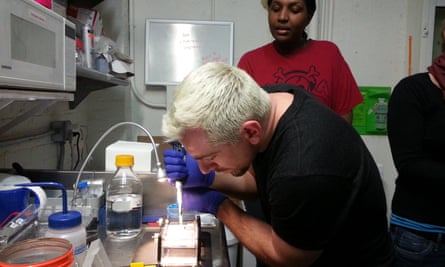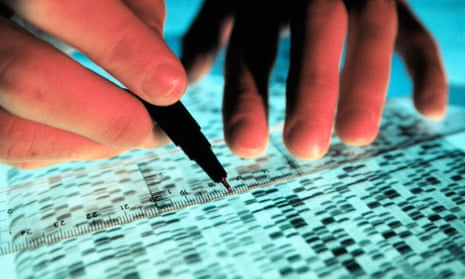On a crowded stretch of Flatbush Avenue in Brooklyn, on the seventh floor of a building gentrification forgot, is a place where you can dabble in genetic engineering. Genspace, a kind of co-working lab for scientists, offers a fully equipped research laboratory available for public use for a modest monthly fee.
It was the first of its kind to open its doors back in 2010 and signaled the rebirth of the gentleman (or gentlewoman) scientist. Since then, BioCurious, another DIY lab, has opened in Silicon Valley, allowing hobbyist biologists to fiddle with their own DNA and titrate their own blood samples. A number of startups like Bento Lab have popped up to serve the DIY Bio movement, making compact desktop versions of traditional biology lab equipment small enough to set up anywhere at home.
Above the din of rumbling trucks and screaming teenagers strolling home from nearby schools, the noise in the Genspace lab that is troubling founder Ellen Jorgensen is a centrifuge. It’s too loud and she is not sure if it is safe to use. The equipment in the lab was donated or purchased secondhand to keep costs down.
In one corner near the communal table that serves as an office sits a small aquarium of the type that usually houses hamsters in elementary schools. It is now home to a few enormous South American cockroaches. A DIY neuroscience company called Backyard Brains used to teach workshops at the lab using a SpikerBox, a device that picks up and displays nerve signals. The easiest way to show those nerve signals is to tear the leg off one of the roaches, attach it to the SpikerBox and stimulate it to show the nerve signals being sent from the leg on an app. Backyard Brains has not run the workshop in a while so the lab inherited the roaches, which Jorgensen has become attached to since she started feeding them. They’re practically pets at this point. “I don’t know how I would feel about the legs coming off,” she says.
Many different people have rotated through the lab, from those needing gel electrophoresis equipment to others looking for low-temperature storage. There are people working on an RNA-based therapy, on genetically engineering E coli to produce cellulose, on trying to turn spent grain from the brewing industry into feed using a fungus and on stabilization work for personal care products. While lab members are all adults, teenagers rotate through as well for science projects and internships.
One teenager diligently working at the lab was diagnosed with ADHD and is using Genspace in his spare time to figure out if he has a particular genetic signature for the disorder. He even got his school to allow him to collect DNA samples from other students for his investigation.
Jorgensen, a trained scientist, runs regular workshops in the evenings on how to modify genes and use the basic equipment. She offers research 101 for those who may not have a traditional science background. While it may seem strange that you can be splicing DNA after one or two workshops, the so-called biohacker movement has made it the norm. Just as there are adult classes for baking cupcakes or repairing old cars, there are now people who try to genetically modify plants after work or on the weekends.
A few factors came together to encourage biohacker hobbyists, Jorgensen explains. There was the rise of the maker movement, as people started trying to do everything themselves, from growing and pickling vegetables to brewing beer. At the same time, there was the standardization of synthetic biology: the idea that DNA could be treated like code, made modular and – with a little training – used by someone without a biology background to run experiments.

“People started asking themselves, ‘If genetically modifying organisms is safe and useful, why couldn’t it be done as a hobby?’” says Jorgensen.
And while the economic downturn in 2008 was bad for a lot of businesses, it was a boon to the DIY biology movement. A lot of companies that folded offloaded their equipment on Ebay, providing used laboratory equipment at an accessible price. At the same time, the price of printing DNA came down to around $0.25 per base, allowing those with just a little money to run experiments.
That confluence of factors drove the creation of public lab space as well as the establishment of personal labs in garages and basements, like the gentlemen (and gentlewomen) scientists of the past. While there was a lot to discover back in the days when the wealthy could tinker in their personal labs, these days experiments are more incremental in terms of the knowledge gained and the complexity of the equipment, but that same intellectual curiosity is driving the work.
Genspace typically attracts people in the 25-30 age range, says Jorgensen. An age range at which people have some disposable income, but don’t yet have familial obligations that would prevent them from spending hours after work tinkering with DNA.
She likens it to a gym membership: some people end up visiting the lab regularly, working for many hours at a time, while others drop off when they see how labor- and time-intensive biological research can be. When the lab first opened, a number of artists from NYU’s Interactive Technology Program rotated through to work on an eight-week thesis in bio art.
These days, however, the backgrounds break down with about a third coming from an IT background and another third from an architectural and design background.
It’s hard to get National Institute of Health support for research as an independent lab, explains Jorgensen, so if a scientist wants to work on their own project it is difficult to get the funds. Most biomedical studies are done out of large universities as funding goes to the consortia of labs that are most likely to get results, so Genspace also provides a place for scientists to do proof of concept experiments to test if ideas are viable before applying for a grant.
Right now, the lab is focused on becoming sustainable. Jorgensen no longer has time to do any research of her own, and spends most of her time fundraising when she is not teaching classes, developing new programming or looking for other organizations to partner with. The lab charges $100 per person for rent each month, and charges for its workshops, but the fees don’t cover the cost of hiring staff members or replacing expensive equipment when it breaks.
This year, the lab got some breathing room when the Simons Foundation provided funding for 2016, giving Genspace a little more time to figure out how to continue growing while balancing its books. The motley mix of people who frequent the lab have not published their personal research yet, but there is something appealing in the idea that someone with a non-traditional science background, with a different way of approaching a problem, may one day discover something beneficial using that noisy secondhand centrifuge.

Comments (…)
Sign in or create your Guardian account to join the discussion